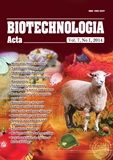ISSN 2410-7751 (Print)
ISSN 2410-776X (Online)

"Biotechnologia Acta" v. 7, no 1, 2014
https://doi.org/10.15407/biotech7.01.087
Р. 87-92, Bibliography 13, Ukrainian
Universal Decimal classification: 621.318.4:616
MECHANOMAGNETIC REACTOR FOR ACTIVATION OF ANTICANCER DRUGS
1National Cancer Institute Ministry of Medical Health, Kyiv, Ukraine
2National Technical University of Ukraine «Kyiv Polytechnic Institute», Kyiv
3Kurdyumov Institute for Metal Physics of National Academy of Sciences of Ukraine, Kyiv
4PAC «Farmac», Department of Research and Development, Kyiv, Ukraine
5Kavetsky Institute of Experimental Pathology, Oncology and Radiobiology of National Academy of Sciences of Ukraine, Kyiv
Mechanomagnetochemical activation can increase the concentration of paramagnetic centers (free radicals) in the anticancer drug, for example, doxorubicin that enables to influence its magnetic properties under external electromagnetic field and improve its magnetic sensitivity and antitumor activity. The principles of design and operation of mechanomagnetic reactor for implementation of this technology which includes mechanomagnetochemical activation and electromagnetic radiation of the drug are described in the paper. The methods of vibration magnetometry, electron paramagnetic resonance spectroscopy and high-performance liquid chromatography were used for studying of doxorubicin mechanomagnetic activation effects.
The studies have shown that a generator of sinusoidal electromagnetic wave, working chambers from caprolactam, fluoroplastic or organic materials with metal inserts and working bodies made from steel or agate depending on the required doxorubicin magnetic properties are expedient to use in the designed mechanomagnic reactor. Under influence of mechanomagnetochemical activation doxorubicin, which is diamagnetic, acquires the properties of paramagnetic without changing g-factors in the spectra of electron paramagnetic resonance. Mechanomagnetochemical activation of doxorubicin satisfies pharmacopoeia condi tions according to the results of liquid chromatography that points on perspective of this method using in technology of tumor therapy with nanosized structures and external electromagnetic radiation.
Key words: free radicals, doxorubicin, mechanomagnetochemical activation.
© Palladin Institute of Biochemistry of National Academy of Sciences of Ukraine, 2014
References
1. Peng X. H., Qian X., Mao H., Wang A. Y., Chen Z. G., Nie S., Shin D. M. Targeted magnetic iron oxide nanoparticles for tumor imaging and therapy. Int. J. Nanomed. 2008, 3(3), 311–321.
2. Chekhun V. F., Todor I. N., Lukyanova N. Y., Shpyleva S. I., Naleskina L. A., Khaetsky I. K.,Kulik G. I. The use of nanoferromagnetics to increase the cytotoxic effect of antitumor drugs. Exp. Oncol. 2009, 31(3), 163–166.
3. Nicolais L., Carotenuto G. Metal-Polymer Nanocomposites. New York: Wiley Interscience. 2005, 300 p.
4. Orel V. E., Kudryavets Yu. I., Bezdenezhnih N. N., Satz S., Danko M. I., Khranovskaya N. N.,Romanov A. V., Dzyatkovskaya N. N., Burlaka A. P. Mechanochemically activated doxorubicin nanoparticles in combination with 40 MHz frequency irradiation on A–549 lung carcinoma cells. Drug Deliv. 2005, N 12, Р. 171–178.
5. Orel V. E., Shevchenko A. D., Melnik Yu. G., Nikolov N. A., Dzyatkovska I. I., Romanov A. V., Burlaka A. P., Lukin S. M., Uvarov V. N., Schepotin I. B. Physicochemical Characteristics of Magnetosensitive Nanocomplex Obtained by Mehanomagnetochemical Technology of Dry Synthesis. Metallofiz. Noveishie. Tekhnol. 2010, 32(9), 1157–1167. (In Ukrainian).
6. Patent № 80456, UA, A61J 3/02. Magneto-mechano-chemical nanoreactor. Orel V. E., Rykhalskiy A. Y. Applied 27.12.2012; Published: 27.05.2013, Journal N 10. (In Ukrainian).
7. Gilbert B. C., Davies M. J. Electron Paramagnetic Resonance. — Cambridge: Royal society of Chemistry. 2006, 414 p.
8. Еuropean Pharmocopoeia 7.0. European Directorate for the Quality of Medicines & Health Care. Doxorubicin Hydrohloride. 2011, 1897–1898.
9. Glinchuk М. D., Ragulya А. V. Nanoferroics. Кyiv.: Naukova dumka. 2010, 311p. (In Russian).
10. Omote Y. An experimental attempt to potentiate therapeutic effects of combined use of pulsing magnetic fields and antitumor agents. Nippon Geka Gakkai Zasshi. 1988. 89(8), 1155–1166.
11. Orel V. E., Movchan B. O., Dzyatkovska I. I., Nikolov M. O., Romanov A. V., Mel’nik Yu. G., Dzyatkovska N. M., Burlaka A. P., Lukin S. M. Research of influencing mechano- and magnetochemically synthesized magnetosensitive complex on the basis of nanoparticles of Fe3O4, doxorubicin and electromagnetic irradiation on animals with Guerin carcinoma. Dopovidi Natsionalnoi Akademii Nauk Ukraini. 2010, N 8, Р. 207–212.(In Ukrainian).
12. Makarova T. L. Magnetic properties of carbon structures. Semiconductors. 2004, 38(6), 615–638.
13. Cohen A. E. Nanomagnetic Control of Intersystem Crossing. J. Phys. Chem. 2009, V. 113, Р. 11084–11092.

